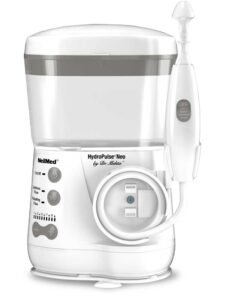Three Steps to Clear Infection in Chronic Sinusitis and Cystic Fibrosis
Once upon a time, actually in the just passed century, if you got a sinus infection, you took an antibiotic and you were cured.
“But that was long ago, in a time far away. ” from the song.
Bacteria Resistant to Antibiotics
Today chronic sinusitis plagues more people than before, despite CT scans, balloon surgery, and daily therapy. Antibiotics are losing their effectiveness; bacteria have built up resistance and biofilm. Biofilm is a nearly impenetrable cocoon that bacteria build around themselves.
In most chronic sinusitis, as in Cystic Fibrosis (CF) , there is a constant battle against infection. The primary factor is a system called Mucociliary Clearance.
Mucociliary Clearance System
Mucociliary Clearance (MC) has to do with a system in the respiratory tract where there is a liquid layer called mucus. This is a thin film that flows freely. Bacteria land here and stick. Under the liquid are millions of tiny hairs called cilia that act like oars. They move the liquid out of the nose or out of the lungs. That way the bacteria don’t have enough time to multiply and cause infection. Normally bacteria are expelled from the nose in about five minutes.
Saccharine Test of Nasal Cilia
To test Mucociliary Clearance, the nasal cilia, take a particle of saccharine and place it in the nose, near the opening, the MC system will move that particle to the back of the throat, down to the area of the tongue where it is tasted, in about five minutes. That is when the MC is normal. Nearly all patients with chronic sinusitis show slow Mucociliary Clearance.(MC) because they have slow moving cilia. In Cystic Fibrosis, the cilia are normal, but they can’t move because the mucus is too thick.
Why You Get Repeat Infections
- In Chronic Sinusitis, typically the patient has an infection in January and responds to antibiotics.
- Then gets another infection in March, but clears with antibiotics.
- Then succumbs to another infection in july.
Yes, the antibiotics clear the bacterial infection, but because the cilia don’t move the bacteria out of the nose, bacteria remain in place and multiply.
Or the situation may be one where daily squeeze bottle irrigations reinfect the patient due to flowback: the bacteria from the nose flows back into the squeeze bottle or pot and multiply there. Then the patient irrigates with a contaminated solution.
When the antibiotic kills all the invading bacteria, there may not be time for natural immunity to develop to that bacteria.
Chronic Sinusitis Therapy
The approach used for CF is applicable to any chronic sinus condition:
- use pulsed irrigation as this is100x more effective in removing thick mucus as well as biofilm from nose or sinuses.
- Use a Ringer’s type saline mixture. This saline formula has been shown to be much more effective than other saline products in clearing bacteria by stimulating nasal cilia
- Reduce bacterial load.
This approach was introduced by Dr Terence Davidson of University of San Diego. He used the Hydro Pulse Nasal/Sinus Irrigator in Cystic Fibrosis to remove the thick mucous layer because, “pulsed irrigation is 100x more effective than simple irrigation.” This allows the nasal cilia to function and move bacteria out of the nose/ sinuses in a normal manner.
Xylitol is added to the Ringer’s irrigation solution. This acts to reduce the number of bacteria – to reduce the bacterial load. With reduced numbers of bacteria, now the natural defenses of the patient (lysozyme, neutrophils, etc) can be used to destroy the bacteria and to build natural immunity against them. With Xylitol, a natural sugar sweetener, there is no build up of bacterial resistance to an antibiotic.
For example, when used in the Hydro Pulse Nasal/Sinus Irrigator, two teaspoons of Xylitol added to the 500 ml of warm water, with one packet of Breathe.ease XL makes a one percent solution of Xylitol in Ringer’s formula.
A major advantage of pulsed irrigation is that once the nasal cilia function is restored, there is no need to continue irrigation. Once the nose is normal, it doesn’t have to be more normal.
References
Boek WM, Graamans K, Natzijl H, et al: Nasal mucociliary transport: new evidence for a key role of ciliary beat frequency. Laryngoscope 2002, 112:570–573
Davidson TM. Management of chronic sinusitis in cystic fibrosis. Laryngoscope.1995 Apr:354-358
Hui, Woods, Carney. A double-blind randomized controlled trial of normal saline, lactated Ringer’s and hypertonic saline irrigation. American Journal of Rhinology. May 2014. 255 – 231

